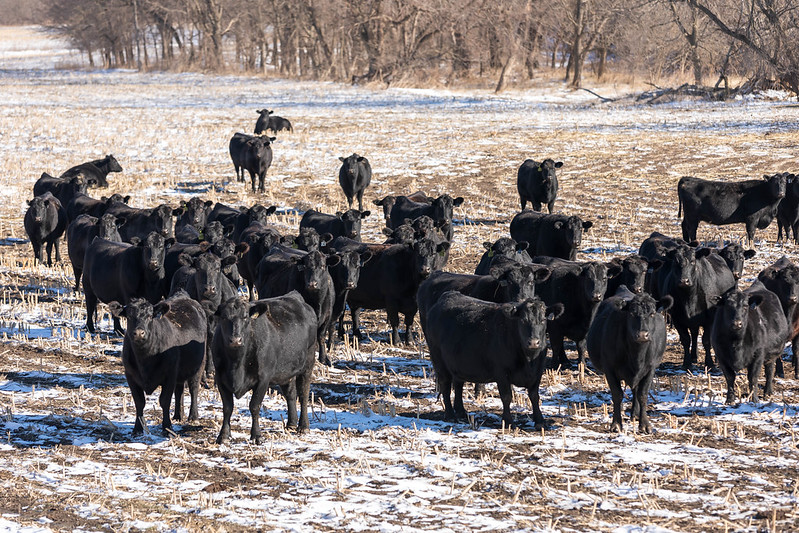
Experts at K-State’s Beef Cattle Institute say first-calf heifers have increased performance when they are not grouped into pastures with cows. | Download this photo.
Cattle Chat: Separating heifers and cows in the months before calving
K-State beef cattle experts recommend grouping heifers away from cows in the months leading up to calving
Dec. 20, 2022
By Lisa Moser, K-State Research and Extension news service
MANHATTAN, Kan. — Metabolisms change throughout life, and consequently so do one’s nutritional needs. This is not only true for people, but for animals as well, said the veterinarians at the Kansas State University Beef Cattle Institute on a recent Cattle Chat podcast.
In the case of cattle, they advise that producers group first-calf heifers away from the mature cows in the months before calving.
“It is important to separate heifers and cows because of their different nutritional needs,” veterinarian Bob Larson said. He explained that bred heifers are about 80-85% of their mature weight, giving them a 200-pound disadvantage when grouped in with the cows.
He said the reason that is worth noting is because of the dominance that cows place over heifers.
“A cow will often not let a younger animal have complete access to feed and water, so it is important to give the younger, smaller heifers their own space where they don’t have to compete as much,” Larson said.
There is also a difference in the type and timing of the feed supplementation between cows and heifers, said beef cattle nutritionist Phillip Lancaster.
“If I start feeding the cowherd like I would a growing replacement heifer, those cows are going to be over-conditioned going into the calving season,” Lancaster said. “Hopefully, those bred heifers will calve 30 days ahead of the rest of the herd so they will need to be switched to a lactation type of diet earlier than the cow herd will need to be.”
From a health standpoint, veterinarian Brian Lubbers said cows and heifers should be grouped separately.
“Prior to calving, producers will need to increase their observations of the heifers to avoid complications and so for that reason they should be separated,” Lubbers said.
Calving in a barn versus a pasture
The K-State experts also discussed the producer’s decision on whether to calve cows in a facility or on pasture.
“Whether you calve the cows out on pasture or in a barn will depend on where you live and what the potential is for severe weather,” Lubbers said.
Calving in a barn does increase the risks for sickness, said Larson, and therefore he recommends letting the cows calve on pastures.
“While a warm calving barn is nice for people to work in, the potential for disease spread among the calves is great because of the air quality and concentration of fecal materials and mud,” he said.
And calf loss at birth does happen on occasion, added veterinarian Brad White.
“Post-natal calf mortality is highest in the first 21 days after birth with most occurring in the first 72 hours after they are born,” White said.
Rather than using a calving barn, Larson advised producers to adjust their calving season to avoid the greatest potential for severe weather; however, White cautioned that does mean a tradeoff due to breeding these cattle in the peak of the summer heat.
To hear the full discussion on these topics, listen to the Cattle Chat podcast online or through your preferred streaming platform.

